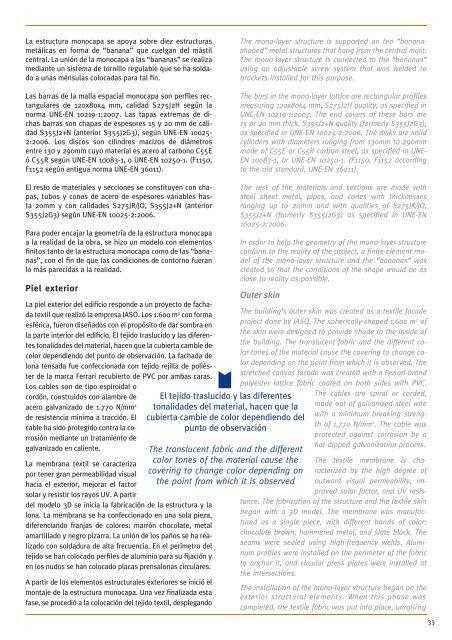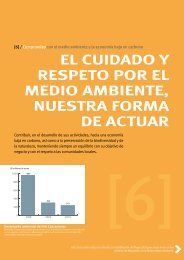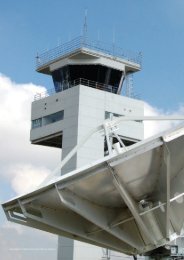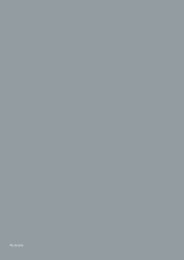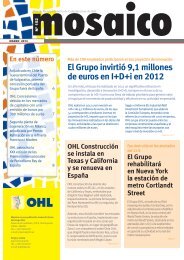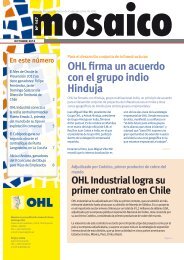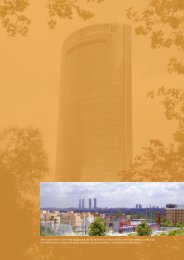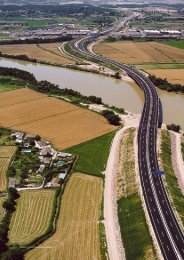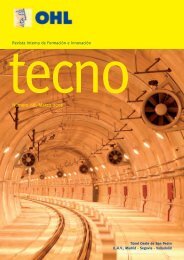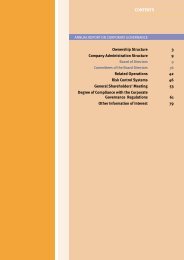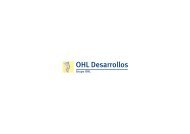Nº 84, Septiembre/September 2012 - Ohl
Nº 84, Septiembre/September 2012 - Ohl
Nº 84, Septiembre/September 2012 - Ohl
Create successful ePaper yourself
Turn your PDF publications into a flip-book with our unique Google optimized e-Paper software.
La estructura monocapa se apoya sobre diez estructuras<br />
metálicas en forma de “banana” que cuelgan del mástil<br />
central. La unión de la monocapa a las “bananas” se realiza<br />
mediante un sistema de tornillo regulable que se ha soldado<br />
a unas ménsulas colocadas para tal fi n.<br />
Las barras de la malla espacial monocapa son perfi les rectangulares<br />
de 120x80x4 mm, calidad S275J2H según la<br />
norma UNE-EN 10219-1:2007. Las tapas extremas de dichas<br />
barras son chapas de espesores 15 y 20 mm de calidad<br />
S355J2+N (anterior S355J2G3), según UNE-EN 10025-<br />
2:2006. Los discos son cilindros macizos de diámetros<br />
entre 130 y 290mm cuyo material es acero al carbono C55E<br />
ó C55R según UNE-EN 10083-1, o UNE-EN 10250-1. (F1150,<br />
F1152 según antigua norma UNE-EN 36011).<br />
El resto de materiales y secciones se constituyen con chapas,<br />
tubos y conos de acero de espesores variables hasta<br />
20mm y con calidades S275JR/JO, S355J2+N (anterior<br />
S355J2G3) según UNE-EN 10025-2:2006.<br />
Para poder encajar la geometría de la estructura monocapa<br />
a la realidad de la obra, se hizo un modelo con elementos<br />
fi nitos tanto de la estructura monocapa como de las “bananas”,<br />
con el fi n de que las condiciones de contorno fueran<br />
lo más parecidas a la realidad.<br />
Piel exterior<br />
La piel exterior del edifi cio responde a un proyecto de fachada<br />
textil que realizó la empresa IASO. Los 1.600 m 2 con forma<br />
esférica, fueron diseñados con el propósito de dar sombra en<br />
la parte interior del edifi cio. El tejido traslucido y las diferentes<br />
tonalidades del material, hacen que la cubierta cambie de<br />
color dependiendo del punto de observación. La fachada de<br />
lona tensada fue confeccionada con tejido rejilla de poliéster<br />
de la marca Ferrari recubierto de PVC por ambas caras.<br />
Los cables son de tipo espiroidal o<br />
cordón, construidos con alambre de<br />
acero galvanizado de 1.770 N/mm 2<br />
de resistencia mínima a tracción. El<br />
cable ha sido protegido contra la corrosión<br />
mediante un tratamiento de<br />
galvanizado en caliente.<br />
La membrana textil se caracteriza<br />
por tener gran permeabilidad visual<br />
hacia el exterior, mejorar el factor<br />
solar y resistir los rayos UV. A partir<br />
del modelo 3D se inicia la fabricación de la estructura y la<br />
lona. La membrana se ha confeccionado en una sola pieza,<br />
diferenciando franjas de colores: marrón chocolate, metal<br />
amartillado y negro pizarra. La unión de los paños se ha realizado<br />
con soldadura de alta frecuencia. En el perímetro del<br />
tejido se han colocado perfi les de aluminio para su fi jación y<br />
en los nudos se han colocado placas prensalonas circulares.<br />
A partir de los elementos estructurales exteriores se inició el<br />
montaje de la estructura monocapa. Una vez fi nalizada esta<br />
fase, se procedió a la colocación del tejido textil, desplegando<br />
El tejido traslucido y las diferentes<br />
tonalidades del material, hacen que la<br />
cubierta cambie de color dependiendo del<br />
punto de observación<br />
The translucent fabric and the different<br />
color tones of the material cause the<br />
covering to change color depending on<br />
the point from which it is observed<br />
The mono-layer structure is supported on ten “bananashaped”<br />
metal structures that hang from the central mast.<br />
The mono-layer structure is connected to the “bananas”<br />
using an adjustable screw system that was welded to<br />
brackets installed for this purpose.<br />
The bars in the mono-layer lattice are rectangular profi les<br />
measuring 120x80x4 mm, S275J2H quality, as specifi ed in<br />
UNE-EN 10219-1:2007. The end covers of these bars are<br />
15 or 20 mm thick, S355J2+N quality (formerly S355J2G3),<br />
as specifi ed in UNE-EN 10025-2:2006. The disks are solid<br />
cylinders with diameters ranging from 130mm to 290mm<br />
made of C55E or C55R carbon steel, as specifi ed in UNE-<br />
EN 10083-1, or UNE-EN 10250-1. (F1150, F1152 according<br />
to the old standard, UNE-EN 36011).<br />
The rest of the materials and sections are made with<br />
steel sheet metal, pipes, and cones with thicknesses<br />
ranging up to 20mm and with qualities of S275JR/JO,<br />
S355J2+N (formerly S355J2G3) as specifi ed in UNE-EN<br />
10025-2:2006.<br />
In order to help the geometry of the mono-layer structure<br />
conform to the reality of the project, a fi nite-element model<br />
of the mono-layer structure and the “bananas” was<br />
created so that the conditions of the shape would be as<br />
close to reality as possible.<br />
Outer skin<br />
The building’s outer skin was created as a textile facade<br />
project done by IASO. The spherically-shaped 1,600 m 2 of<br />
the skin were designed to provide shade to the inside of<br />
the building. The translucent fabric and the different color<br />
tones of the material cause the covering to change color<br />
depending on the point from which it is observed. The<br />
stretched canvas facade was created with a Ferrari-brand<br />
polyester lattice fabric coated on both sides with PVC.<br />
The cables are spiral or corded,<br />
made out of galvanized steel wire<br />
with a minimum breaking strength<br />
of 1,770 N/mm 2 . The cable was<br />
protected against corrosion by a<br />
hot-dipped galvanization process.<br />
The textile membrane is characterized<br />
by the high degree of<br />
outward visual permeability, improved<br />
solar factor, and UV resistance.<br />
The fabrication of the structure and the textile skin<br />
began with a 3D model. The membrane was manufactured<br />
as a single piece, with different bands of color:<br />
chocolate brown, hammered metal, and slate black. The<br />
seams were sealed using high-frequency welds. Aluminum<br />
profi les were installed on the perimeter of the fabric<br />
to anchor it, and circular press plates were installed at<br />
the intersections.<br />
The installation of the mono-layer structure began on the<br />
exterior structural elements. When this phase was<br />
completed, the textile fabric was put into place, unrolling<br />
33


